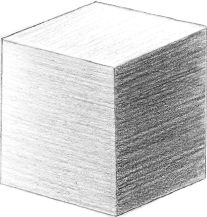One of the main challenges of drawing is making a flat, two-dimensional image look like a three-dimensional object—you can do this by including variations in value in your drawings. Value refers to the relative lightness or darkness of a color or of black. By shading (adding dark values) and highlighting (adding light values), you produce the value variations which create the illusion of depth.
Just as a musician uses a musical scale to measure a range of notes, an artist uses a value scale to measure changes in value. You can refer to the value scale so you’ll always know how dark to make your dark values and how light to make your highlights. The scale also serves as a guide for transitioning from lighter to darker shades.

Creating a Value Scale Making your own value scale will help familiarize you with the different variations in value. Work from light to dark, adding more and more tone for successively darker values.

Blending Values Now create a blended value scale—use a blending stump to smudge and blend each value into its neighboring value from light to dark. This will show you how one value blends into the next as they gradually get darker.
Every shape or form we see is created by the reaction of the object’s surface to light. In order to create a strong three-dimensional quality, the subject must be lit in a way that brings out its form. For example, if you light an object from the front, you won’t see the shadows that fall across the form, and it will appear to be flattened. If you light the object from a three-quarter angle, the object will produce shadows, and the transition in values will accentuate the dimensions of the form.
There are two main types of shadows: form shadows and cast shadows. Form shadows are the shadows that are on the surface of the object itself—these shadows give an object a sense of depth. Form shadows are dependent on the lighting source for your object; they get darker as they move away from the light. Cast shadows are the shadows that the object throws onto other surfaces. (Think of the shadow cast by a tree on a sunny day.)

Adding Depth with Light Here you can see value at work. By shading the sides of this object, I have created the appearance of depth. Making one side of the cube dark and the other light makes it seem that each side is in a different space. As you can see, the direction of my strokes follow the form of the object.
